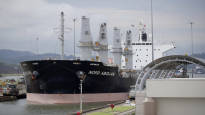The passage of one ship through the Panama Canal takes as much water as half a million Panamanians consume per day, according to Foreign Policy.
Yemeni Houthi rebels’ attacks on ships in the Red Sea are disrupting world trade. Another of the world’s most important shipping routes – the Panama Canal – is also in trouble.
40 percent of US container traffic and about five percent of global seaborne trade pass through the Panama Canal, says Foreign Policy magazine.
Now trade volumes in the Suez Canal leading from the Red Sea to the Mediterranean have dropped by 40 percent. Trade through the Panama Canal, which connects the Atlantic and the Pacific, has fallen by 30 percent since November, reports the financial magazine The Economist last week.
The Panama Canal is plagued by the drying up of the lakes that bring water to it, which has led to restrictions on traffic.
The canal authorities announced yesterday, Wednesday, that 24 ships can now pass through the canal every day. In December, the traffic was less, 22 ships per day, the channel says in the release. The authorities previously predicted that traffic would have to be cut more this year. Normally, around 36 ships pass through the channel per day.
The drought has caused congestion, special arrangements and concerns about the effects on international trade. The giant shipping company Maersk informed its customers last week that ships bringing cargo from, for example, Australia will no longer travel along the canal due to the lack of water. Instead, Maersk transports the cargo by land. The matter was told by an American news channel CNBC.
The canal consumes large amounts of water
According to the Panama Canal authorities, better water treatment than before and an increase in rainfall in November have made it possible for there to be enough water for the passage of at least 24 ships a day until the end of April, reports news agency AP. At that time, the new rainy season begins.
According to the authorities, the drought is caused by climate change and the El Niño phenomenon. El Niño, which occurs every few years in the Pacific Ocean, temporarily raises the global average temperature.
According to AP, the authorities warned that Panama must urgently look for new water sources to secure the operation of the canal and for people to use it. The same lakes from which the water goes to the canal also provide water to more than half of Panama’s more than four million people.
According to Foreign Policy, the passage of one ship through the canal takes as much water as half a million Panamanians consume in a day.
